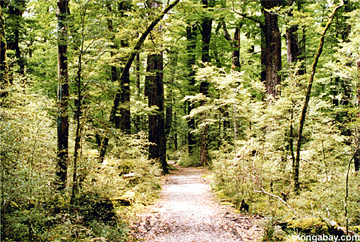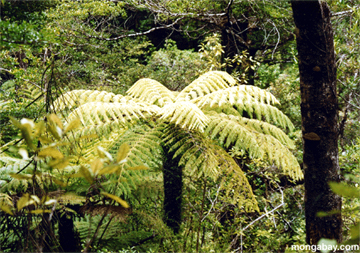Tropical vegetation grew along the coast of Antarctica 52 million years ago, an indication to dramatic climate shifts linked to elevated carbon dioxide levels in the atmosphere, report scientists in Nature.
The research, led by a team from the Goethe University and the Biodiversity and Climate Research Centre in Frankfurt, Germany, is based on drill cores from the seafloor near Antarctica. The cores turned up evidence of tropical and sub-tropical species, including palms and relatives of Baobab trees, which thrived in a period when atmospheric CO2 levels were more than twice current levels. The authors used this data, together with signatures of soil bacteria, to reconstruct vegetation communities for parts of the icy continent.
The scientists say the findings are important given the current trend in CO2 levels, which are rising due to burning of fossil fuels.
  Subtropical vegetation in New Zealand. Photos by Rhett A. Butler |
“If the current CO2 emissions continue unabated due to the burning of fossil fuels, CO2 concentrations in the atmosphere, as they existed in the distant past, are likely to be achieved within a few hundred years”, said Pross, a paleoclimatologist at the Goethe University and member of the Biodiversity and Climate Research Centre, in a statement. “By studying naturally occurring climate warming periods in the geological past, our knowledge of the mechanisms and processes in the climate system increases. This contributes enormously to improving our understanding of current human-induced global warming.”
The research suggests the presence of tropical and subtropical rainforests in costal regions of Antarctica, with temperate rainforests similar to those in present-day New Zealand in the cooler interior. The forests survived despite the three months of polar night annually.
But it wasn’t only elevated CO2 levels that drove the mild conditions in Antarctica.
“Another important factor was the transfer of heat via warm ocean currents that reached Antarctica,” said Pross.
“When the warm ocean current collapsed and the Antarctic coast came under the influence of cooler ocean currents, the tropical rainforests including palms and Baobab relatives also disappeared,” concluded the statement from Goethe University.
CITATION: Pross, J., Contreras, L., Bijl, P.K., Greenwood, D.R., Bohaty, S.M., Schouten, S., Bendle, J.A., Röhl, U., Tauxe, L., Raine, J.I., Huck, C.E., van de Flierdt, T., Jamieson, S.S.R., Stickley, C.E., van de Schootbrugge, B., Escutia, C., Brinkhuis, H., IODP Expedition 318 Scientists (2012): Persistent near-tropical warmth on the Antarctic continent during the early Eocene epoch. Nature, DOI: 10.1038/nature11300
Related articles